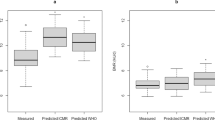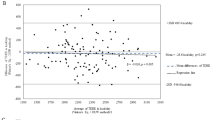Abstract
Background/Objectives:
Objective and subjective measurement instruments have been used to estimate energy expenditure (EE) as alternatives to the doubly labeled water (DLW) methodology, but their relative validity for older adults remains uncertain. The purpose of this study was to validate an objective monitor (SenseWear Mini Armband) and a self-report instrument (7-Day Physical Activity Recall, 7D-PAR) relative to the DLW under free-living conditions in older adults.
Subjects/Methods:
Twenty-nine older adults (60–78 years) each wore the Mini for 14 consecutive days and completed two 7D-PARs after each week. For each measurement method, activity EE (AEE) was calculated as total EE (TEE)—measured resting metabolic rate (RMR)—diet induced thermogenesis (10% of TEE). TEE and AEE from the Mini and 7D-PAR were each compared with values from the DLW.
Results:
Equivalence testing indicated that estimates of TEE from the Mini and the 7D-PAR were statistically equivalent to those measured with DLW; however, differences were evident for estimates of AEE. The Mini had smaller mean absolute percent error for TEE (8.0%) and AEE (28.4%) compared with the 7D-PAR (13.8 and 84.5%, respectively) and less systematic bias in the estimates.
Conclusions:
The Mini and 7D-PAR provided reasonably valid estimates of TEE but large errors in estimating AEE. The Mini and 7D-PAR have the potential to accurately estimate TEE for older adults.
This is a preview of subscription content, access via your institution
Access options
Subscribe to this journal
Receive 12 print issues and online access
$259.00 per year
only $21.58 per issue
Buy this article
- Purchase on Springer Link
- Instant access to full article PDF
Prices may be subject to local taxes which are calculated during checkout


Similar content being viewed by others
References
Sherman SE, Dagostino RB, Cobb JL, Kannel WB . Does exercise reduce mortality-rates in the elderly—experience from the Framingham Heart Study. Am Heart J 1994; 128: 965–972.
Shahar DR, Yu B, Houston DK, Kritchevsky SB, Lee JS, Rubin SM et al. Dietary factors in relation to daily activity energy expenditure and mortality among older adults. J Nutr Health Aging 2009; 13: 414–420.
Wijsman CA, Westendorp RGJ, EALM Verhagen, Catt M, Slagboom E, de Craen AJM et al. Effects of a web-based intervention on physical activity and metabolism in older adults: randomized controlled trial. J Med Internet Res 2013; 15: e233.
Zhao G, Ford ES, Li C, Balluz LS . Physical activity in U.S. older adults with diabetes mellitus: prevalence and correlates of meeting physical activity recommendations. J Am Geriatr Soc 2011; 59: 132–137.
Middleton LE, Manini TM, Simonsick EM, Harris TB, Barnes DE, Tylavsky F et al. Activity energy expenditure and incident cognitive impairment in older adults. Arch Intern Med 2011; 171: 1251–1257.
United States Department of Health and Human Services. 2008 Physical Activity Guidelines for Americans: Be Active, Healthy, and Happy!. US Department of Health and Human Services: Washington, DC, 2008.
Black AE, Coward WA, Cole TJ, Prentice AM . Human energy expenditure in affluent societies: An analysis of 574 doubly-labelled water measurements. Eur J Clin Nutr 1996; 50: 72–92.
Johannsen DL, DeLany JP, Frisard MI, Welsch MA, Rowley CK, Fang X et al. Physical activity in aging: comparison among young, aged, and nonagenarian individuals. J Appl Physiol (1985) 2008; 105: 495–501.
Blumenthal HT . Normal human aging - the Baltimore Longitudinal-Study of Aging—Shock,Nw, Greulich,Re, Andres,R, Arrenberg,D, Costa,Pt, Lakatta,Eg, Tobin, Jd. J Gerontol 1985; 40: 767–767.
Manini TM, Everhart JE, Anton SD, Schoeller DA, Cummings SR, Mackey DC et al. Activity energy expenditure and change in body composition in late life. Am J Clin Nutr 2009; 90: 1336–1342.
Speakman JR, Westerterp KR . Associations between energy demands, physical activity, and body composition in adult humans between 18 and 96 y of age. Am J Clin Nutr 2010; 92: 826–834.
Newman AB, Lee JS, Visser M, Goodpaster BH, Kritchevsky SB, Tylavsky FA et al. Weight change and the conservation of lean mass in old age: the Health, Aging and Body Composition Study. Am J Clin Nutr 2005; 82: 872–878. quiz 915-876.
Morley JE . Anorexia of aging: physiologic and pathologic. Am J Clin Nutr 1997; 66: 760–773.
Montoye HJ, Kemper HC, Saris WHM, Washburn RA . Measuring Physical Activity and Energy Expenditure. Human Kinetics: Champaign, IL, 1996.
Starling RD . Use of doubly labeled water and indirect calorimetry to assess physical activity. In: Welk GJ (ed). Physical Activity Assessments for Health-Related Research. Human Kinetics: Champaign, IL, 2002, pp 197–209.
Westerterp KR, Brouns F, Saris WHM, Tenhoor F . Comparison of doubly labeled water with respirometry at low-activity and high-activity levels. J Appl Physiol 1988; 65: 53–56.
Schoeller DA . Recent advances from application of doubly labeled water to measurement of human energy expenditure. J Nutr 1999; 129: 1765–1768.
Bonnefoy M, Normand S, Pachiaudi C, Lacour JR, Laville M, Kostka T . Simultaneous validation of ten physical activity questionnaires in older men: a doubly labeled water study. J Am Geriatr Soc 2001; 49: 28–35.
Seale JL, Klein G, Friedmann J, Jensen GL, Mitchell DC, Smiciklas-Wright H . Energy expenditure measured by doubly labeled water, activity recall, and diet records in the rural elderly. Nutrition 2002; 18: 568–573.
Schuit AJ, Schouten EG, Westerterp KR, Saris WHM . Validity of the physical activity scale for the elderly (PASE): according to energy expenditure assessed by the doubly labeled water method. J Clin Epidemiol 1997; 50: 541–546.
Colbert LH, Matthews CE, Havighurst TC, Kim K, Schoeller DA . Comparative validity of physical activity measures in older adults. Med Sci Sport Exer 2011; 43: 867–876.
Mackey DC, Manini TM, Schoeller DA, Koster A, Glynn NW, Goodpaster BH et al. Validation of an armband to measure daily energy expenditure in older adults. J Gerontol A Biol Sci Med Sci 2011; 66: 1108–1113.
Bowles HR . Measurement of active and sedentary behaviors: closing the gaps in self-report methods. J Phys Act Health 2012; 9 (Suppl 1): S1–S4.
Troiano RP, Pettee Gabriel KK, Welk GJ, Owen N, Sternfeld B . Reported physical activity and sedentary behavior: why do you ask?. J Phys Act Health 2012; 9 (Suppl 1): S68–S75.
Johannsen DL, Calabro MA, Stewart J, Franke W, Rood JC, Welk GJ . Accuracy of armband monitors for measuring daily energy expenditure in healthy adults. Med Sci Sports Exerc 2010; 42: 2134–2140.
Levine JA . Nonexercise activity thermogenesis (NEAT): environment and biology. Am J Physiol Endocrinol Metab 2005; 288: E285–E285.
Racette SB, Schoeller DA, Luke AH, Shay K, Hnilicka J, Kushner RF . Relative Dilution Spaces of H-2-Labeled and O-18-Labeled Water in Humans. Am J Physiol Endocrinol Metab 1994; 267: E585–E590.
Ainsworth BE, Haskell WL, Whitt MC, Irwin ML, Swartz AM, Strath SJ et al. Compendium of Physical Activities: an update of activity codes and MET intensities. Med Sci Sport Exer 2000; 32: S498–S516.
Washburn RA, Jacobsen DJ, Sonko BJ, Hill JO, Donnelly JE . The validity of the Stanford seven-day physical activity recall in young adults. Med Sci Sport Exer 2003; 35: 1374–1380.
Dixon PM, Pechmann JHK . A statistical test to show negligible trend. Ecology 2005; 86: 1751–1756.
Wellek S . Testing Statistical Hypotheses of Equivalence. Chapman & Hall/CRC: Boca Raton, FL, 2003.
Bland JM, Altman DG . Statistical Methods for Assessing Agreement between Two Methods of Clinical Measurement. Lancet 1986; 1: 307–310.
Goran MI . Energy metabolism and obesity. Med Clin North Am 2000; 84: 347–362.
Besson H, Brage S, Jakes RW, Ekelund U, Wareham NJ . Estimating physical activity energy expenditure, sedentary time, and physical activity intensity by self-report in adults. Am J Clin Nutr 2010; 91: 106–114.
Mahabir S, Baer DJ, Giffen C, Clevidence BA, Campbell WS, Taylor PR et al. Comparison of energy expenditure estimates from 4 physical activity questionnaires with doubly labeled water estimates in postmenopausal women. Am J Clin Nutr 2006; 84: 230–236.
Adams SA, Matthews CE, Ebbeling CB, Moore CG, Cunningham JE, Fulton J et al. The effect of social desirability and social approval on self-reports of physical activity. Am J Epidemiol 2005; 161: 389–398.
Byrne NM, Hills AP, Hunter GR, Weinsier RL, Schutz Y . Metabolic equivalent: one size does not fit all. J Appl Physiol 2005; 99: 1112–1119.
Welk GJ, Thompson RW, Gaper DI . Temporal validation of scoring algorithms for the 7-day physical activity recall. Meas Phy Edu Exer Sci 2001; 5: 123–138.
Acknowledgements
We acknowledge the enthusiastic support of the volunteers who participated in this study. The authors have no personal relationships with the National Institutes of Health that financially supported this study. This work was supported by a National Institute of Health grant (HL091024-04).
Author information
Authors and Affiliations
Corresponding author
Ethics declarations
Competing interests
The authors declare no conflict of interest.
Rights and permissions
About this article
Cite this article
Calabro, M., Kim, Y., Franke, W. et al. Objective and subjective measurement of energy expenditure in older adults: a doubly labeled water study. Eur J Clin Nutr 69, 850–855 (2015). https://doi.org/10.1038/ejcn.2014.241
Received:
Revised:
Accepted:
Published:
Issue Date:
DOI: https://doi.org/10.1038/ejcn.2014.241
This article is cited by
-
Total Energy Expenditure and Functional Status in Older Adults: A Doubly Labelled Water Study
The journal of nutrition, health & aging (2021)
-
Association of Lower-Extremity Muscle Performance and Physical Activity Level and Intensity in Middle-Aged and Older Adults: A Doubly Labeled Water and Accelerometer Study
The journal of nutrition, health & aging (2020)
-
Activity energy expenditure is an independent predictor of energy intake in humans
International Journal of Obesity (2019)
-
Total energy expenditure in adults aged 65 years and over measured using doubly-labelled water: international data availability and opportunities for data sharing
Nutrition Journal (2018)
-
Energy expenditure estimation from respiration variables
Scientific Reports (2017)



